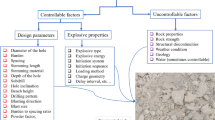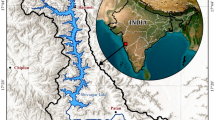Abstract
Mines, quarries and construction sites face environmental impacts, such as flyrock, due to blasting operations. Flyrock may cause damage to structures and injury to human. Therefore, flyrock prediction is required to determine safe blasting zone. In this regard, 232 blasting operations were investigated in five granite quarries, Malaysia. Blasting parameters comprising maximum charge per delay and powder factor were prepared to predict flyrock using empirical and intelligent methods. An empirical graph was proposed to predict flyrock distance for different powder factor values. In addition, using the same datasets, two intelligent systems, namely artificial neural network (ANN) and adaptive neuro-fuzzy inference system (ANFIS) were used to predict flyrock. Considering some model performance indices including coefficient of determination (R 2), value account for and root mean squared error and also using simple ranking procedure, the best flyrock prediction models were selected. It was found that the ANFIS model can predict flyrock with higher performance capacity compared to ANN predictive model. R 2 values of testing datasets are 0.925 and 0.964 for ANN and ANFIS techniques, respectively, suggesting the superiority of the ANFIS technique in predicting flyrock.








Similar content being viewed by others
References
Khandelwal K, Monjezi M (2013) Prediction of flyrock in open pit blasting operation using machine learning method. Int J Min Sci Technol 23(3):313–316
Singh TN, Singh V (2005) An intelligent approach to prediction and control ground vibration in mines. Geotech Geolog Eng 23:249–262
Rezaei M, Monjezi M, Yazdian Varjani A (2011) Development of a fuzzy model to predict flyrock in surface mining. Safety Sci 49(2):298–305
Hajihassani M, Jahed Armaghani D, Sohaei H, Tonnizam Mohamad E, Marto A (2014) Prediction of airblast-overpressure induced by blasting using a hybrid artificial neural network and particle swarm optimization. Appl Acoust 80:57–67
Roy PP (2005) Rock blasting effects and operations. Taylor & Francis, Boca Raton
Raina AK, Murthy VMSR, Soni AK (2014) Flyrock in bench blasting: a comprehensive review. Bull Eng Geol Environ. doi:10.1007/s10064-014-0588-6
Bhandari S (1997) Engineering rock blasting operations. Taylor & Francis, Boca Raton
Bajpayee TS, Rehak TR, Mowrey GL, Ingram DK (2004) Blasting injuries in surface mining with emphasis on flyrock and blast area security. J Safety Res 35(1):47–57
Hemphill GB (1981) Blasting operations. McGraw-Hill, New York
Koop JW (1994) Observation of flyrock of several mines and quarries. In: Proceeding of 20th Conference on Explosives and Blasting Technique Austin Texas, 30 January–3 February. Cleveland International Society of Explosives Engineers, pp 75–81
Kecojevic V, Radomsky M (2005) Flyrock phenomena and area security in blasting-related accidents. Safety Sci 43:739–750
Workman JL, Calder PN (1994) Flyrock prediction and control in surface mine blasting. In: Proceeding of 20th Conference on Explosives and Blasting Technique. Austin, Texas, 30 January–3 February. International Society of Explosives Engineers, Cleveland, pp 59–74
Lundborg N, Persson N, Ladegaard-Pedersen A, Holmberg R (1975) Keeping the lid on flyrock in open pit blasting. Eng Min J 176:95–100
Roth JA (1979) A model for the determination of flyrock range as a function of shot condition. US department of commerce. NTIS report no. PB81222358
Chiapetta RF, Bauer A, Dailey PJ, Burchell SL (1983) The use of high-speed motion picture photography in blast evaluation and design. Proceedings of 9th conference on explosives and blasting techniques. Dallas, USA, pp 31–40
Gupta RN (1980) Surface blasting and its impact on environment. In: Trivedy NJ, Singh BP (eds) Impact of mining on environment. Ashish Publishing House, New Delhi, pp 23–24
Roy PP (1993) Putting ground vibration predictors into practice. Colliery Guardian 241:63–67
Monjezi M, Bahrami A, Yazdian Varjani A (2010) Simultaneous prediction of fragmentation and flyrock in blasting operation using artificial neural networks. Int J Rock Mech Min Sci 47(3):476–480
Jahed Armaghani D, Hajihassani M, Tonnizam Mohamad E, Marto A, Noorani SA (2014) Blasting-induced flyrock and ground vibration prediction through an expert artificial neural network based on particle swarm optimization. Arab J Geosci 7:5383–5396
Bahrami A, Monjezi M, Goshtasbi K, Ghazvinian A (2011) Prediction of rock fragmentation due to blasting using artificial neural network. Eng Comput 27(2):177–181
Khandelwal M, Kumar DL, Yellishetty M (2011) Application of soft computing to predict blast-induced ground vibration. Eng Comput 27(2):117–125
Iphar M, Yavuz M, Ak H (2008) Prediction of ground vibrations resulting from the blasting operations in an open-pit mine by adaptive neuro-fuzzy inference system. Environ Geol 56:97–107
Singh TN, Verma AK (2012) Comparative analysis of intelligent algorithms to correlate strength and petrographic properties of some schistose rocks. Eng Comput 28(1):1–12
Hajihassani M, Jahed Armaghani D, Marto A, Tonnizam Mohamad E (2014) Ground vibration prediction in quarry blasting through an artificial neural network optimized by imperialist competitive algorithm. Bull Eng Geol Environ. doi:10.1007/s10064-014-0657-x
Gordan B, Jahed Armaghani D, Hajihassani M, Monjezi M (2015) Prediction of seismic slope stability through combination of particle swarm optimization and neural network. Eng Comput. doi:10.1007/s00366-015-0400-7
Garret JH (1994) Where and why artificial neural networks are applicable in civil engineering. J Comput Civil Eng 8:129–130
Stojadinovic S, Pantovic R, Zikic M (2011) Prediction of flyrock trajectories for forensic applications using ballistic flight equations. Int J Rock Mech Min Sci 48:1086–1094
Mandal SK (1997) Causes of flyrock damages and its remedial measures. Course on: recent advances in blasting techniques in mining and construction projects, HRD-CMRI Dhanbad, pp 130–136
Adhikari GR (1999) Studies on flyrock at limestone quarries. Rock Mech Rock Eng 32(4):291–301
Fletcher LR, D’Andrea DV (1987) Reducing accident through improved blasting safety. USBM IC, 9135. In: Proceedings of bureau of mines technology transfer sem, Chicago, pp 6–18
Raina AK, Chakraborty AK, More R, Choudhury PB (2006) Design of factor of safety based criterion for control of flyrock/throw and optimum fragmentation. J Inst Eng India 87:13–17
McKenzie CK (2009) Flyrock range and fragment size prediction. http://docs.isee.org/ISEE/Support/Proceed/General/09GENV2/09v206g.pdf
Trivedi R, Singh TN, Raina AK (2014) Prediction of blast-induced flyrock in Indian limestone mines using neural networks. J Rock Mech Geotech Eng 6(5):447–454
Ghasemi E, Sari M, Ataei M (2012) Development of an empirical model for predicting the effects of controllable blasting parameters on flyrock distance in surface mines. Int J Rock Mech Min Sci 52:163–170
Ghasemi E, Amini H, Ataei M, Khalokakaei R (2014) Application of artificial intelligence techniques for predicting the flyrock distance caused by blasting operation. Arab J Geosci 7(1):193–202
Monjezi M, Khoshalan HA, Varjani AY (2012) Prediction of flyrock and backbreak in open pit blasting operation: a neuro-genetic approach. Arab J Geosci 5(3):441–448
Monjezi M, Bahrami A, Varjani AY, Sayadi AR (2011) Prediction and controlling of flyrock in blasting operation using artificial neural network. Arab J Geosci 4:421–425
Amini H, Gholami R, Monjezi M, Torabi SR, Zadhesh J (2012) Evaluation of flyrock phenomenon due to blasting operation by support vector machine. Neural Comput Appl 21(8):2077–2085
Monjezi M, Mehrdanesh A, Malek A, Khandelwal M (2013) Evaluation of effect of blast design parameters on flyrock using artificial neural networks. Neural Comput Appl 23(2):349–356
Marto A, Hajihassani M, Jahed Armaghani D, Tonnizam Mohamad E, Makhtar AM (2014) A novel approach for blast-induced flyrock prediction based on imperialist competitive algorithm and artificial neural network. Sci World J (Article ID 643715)
Simpson PK (1990) Artificial neural system: foundation, paradigms, applications and implementations. Pergamon, New York
Shahin MA, Maier HR, Jaksa MB (2002) Predicting settlement of shallow foundations using neural networks. J Geotech Geoenviron Eng 128(9):785–793
Haykin S (1999) Neural Networks, 2nd edn. Prentice-Hall, Englewood Cliffs
Du KL, Lai AKY, Cheng KKM, Swamy MNS (2002) Neural methods for antenna array signal processing: a review. Signal Process 82:547–561
Kalinli A, Acar MC, Gunduz Z (2011) New approaches to determine the ultimate bearing capacity of shallow foundations based on artificial neural networks and ant colony optimization. Eng Geol 117:29–38
Engelbrecht AP (2007) Computational intelligence: an introduction. Wiley, New York
Dreyfus G (2005) Neural Networks: methodology and application. Springer, Berlin, Heidelberg
Kosko B (1994) Neural networks and fuzzy systems: a dynamical systems approach to machine intelligence. Prentice Hall, New Delhi
Fausett LV (1994) Fundamentals of neural networks: architecture, algorithms and applications. Prentice-Hall, Englewood Cliffs
Jang RJS (1993) Anfis: adaptive-network-based fuzzy inference system. IEEE Trans Syst Man Cybern 23:665–685
Jang RJS, Sun CT, Mizutani E (1997) Neuro-fuzzy and soft computing. Prentice-Hall, Upper Saddle River, p 614
Jahed Armaghani D, Tonnizam Mohamad E, Momeni E, Narayanasamy MS, Mohd Amin MF (2014) An adaptive neuro-fuzzy inference system for predicting unconfined compressive strength and Young’s modulus: a study on main range granite. Bull Eng Geol Environ. doi:10.1007/s10064-014-0687-4
Ataei M, Kamali M (2012) Prediction of blast-induced vibration by adaptive neuro-fuzzy inference system in Karoun 3 power plant and dam. J Vib Control 22:1–9
Singh R, Kainthola A, Singh TN (2012) Estimation of elastic constant of rocks using an ANFIS approach. Appl Soft Comput 12(1):40–45
ISRM (2007) In: Ulusay and Hudson (eds) The complete ISRM suggested methods for rock characterization, testing and monitoring: 1974–2006. Suggested methods prepared by the commission on testing methods. International Society for Rock Mechanics
Hush DR (1989) Classification with neural networks: a performance analysis. Proceedings of the IEEE International Conference on Systems Engineering. Dayton, USA, pp 277–280
Kanellopoulas I, Wilkinson GG (1997) Strategies and best practice for neural network image classification. Int J Remote Sensing 18:711–725
Hecht-Nielsen R (1987) Kolmogorov’s mapping neural network existence theorem. In: Proceedings of the First IEEE International Conference on Neural Networks, San Diego, CA, USA, pp 1–14
Hornik K, Stinchcombe M, White H (1989) Multilayer feedforward networks are universal approximators. Neural Networks 2:359–366
Baheer I (2000) Selection of methodology for modeling hysteresis behavior of soils using neural networks. J Comput Aid Civil Infrastruct Eng 5(6):445–463
Sonmez H, Gokceoglu C, Nefeslioglu HA, Kayabasi A (2006) Estimation of rock modulus: for intact rocks with an artificial neural network and for rock masses with a new empirical equation. Int J Rock Mech Min Sci 43:224–235
Sonmez H, Gokceoglu C (2008) Discussion on the paper by H. Gullu and E. Ercelebi A neural network approach for attenuation relationships: an application using strong ground motion data from Turkey. Eng Geol 97:91–93
Ripley BD (1993) Statistical aspects of neural networks. In: Barndoff-Neilsen OE, Jensen JL, Kendall WS (eds) Networks and chaos-statistical and probabilistic aspects. Chapman & Hall, London, pp 40-123
Paola JD (1994) Neural network classification of multispectral imagery. MSc thesis, The University of Arizona, USA
Wang C (1994) A theory of generalization in learning machines with neural application. PhD thesis, The University of Pennsylvania, USA
Masters T (1994) Practical neural network recipes in C ++. Academic Press, Boston
Kaastra I, Boyd M (1996) Designing a neural network for forecasting financial and economic time series. Neurocomputing 10:215–236
Swingler K (1996) Applying neural networks: a practical guide. Academic Press, New York
Looney CG (1996) Advances in feed-forward neural networks: demystifying knowledge acquiring black boxes. IEEE Trans Knowl Data Eng 8(2):211–226
Nelson M, Illingworth WT (1990) A practical guide to neural nets. Addison-Wesley, Reading
Yagiz S, Gokceoglu C, Sezer E, Iplikci S (2009) Application of two non-linear prediction tools to the estimation of tunnel boring machine performance. Eng Appl Artif Intel 22(4):808–814
Demuth H, Beale M, Hagan M (2009) MATLAB Version 7.14.0.739; Neural Network Toolbox for Use with Matlab. The Mathworks
Zorlu K, Gokceoglu C, Ocakoglu F, Nefeslioglu HA, Acikalin S (2008) Prediction of uniaxial compressive strength of sandstones using petrography-based models. Eng Geol 96(3):141–158
Acknowledgments
The authors would like to extend their appreciation to the Government of Malaysia and Universiti Teknologi Malaysia for the FRGS Grant No. 4F406 and for providing the required facilities that made this research possible.
Author information
Authors and Affiliations
Corresponding author
Rights and permissions
About this article
Cite this article
Jahed Armaghani, D., Tonnizam Mohamad, E., Hajihassani, M. et al. Evaluation and prediction of flyrock resulting from blasting operations using empirical and computational methods. Engineering with Computers 32, 109–121 (2016). https://doi.org/10.1007/s00366-015-0402-5
Received:
Accepted:
Published:
Issue Date:
DOI: https://doi.org/10.1007/s00366-015-0402-5




